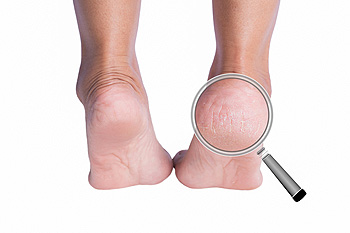Items filtered by date: March 2023
Runners and Cracked Heels

People who enjoy running can experience many benefits including increased endorphins. Conversely, avid runners may see they have developed cracked heels, which can cause pain and discomfort while making it difficult to run. There are generally four stages that runners see when developing cracked heels, which begin with their feet becoming red, sensitive, and dry. This can be followed by an itchy and burning sensation, which can lead to cracked and peeling skin. If treatment is not started, the cracks in the skin may begin to bleed, causing the feet to look unattractive. A common reason for cracked heels to develop is a lack of hydration of the skin. Cracked heels found in runners are often increased as a result of the impact of running, and from wearing socks and shoes that may become sweaty. If you have developed this foot condition, it is suggested that you consult with a podiatrist who can guide you toward the treatment method that is correct for you.
If the skin on your feet starts to crack, you may want to see a podiatrist to find treatment. If you have any concerns, contact Kimberly Woodard, DPM from Pinnacle Foot and Ankle Centers, LLC . Our doctor can provide the care you need to keep you pain-free and on your feet.
Cracked Heels
It is important to moisturize your cracked heels in order to prevent pain, bleeding, and infection. The reason cracked heels form is because the skin on the foot is too dry to support the immense pressure placed on them. When the foot expands, the dry skin on the foot begins to split.
Ways to Help Heal Them
- Invest in a good foot cream
- Try Using Petroleum Jelly
- Ease up on Soaps
- Drink Plenty of Water
Ways to Prevent Cracked Heels
- Moisturize After Showering
- Skip a Shower
- Keep Shower Water Lukewarm
- Don’t Scrub Your Feet
If you are unsure how to proceed in treating cracked heels, seek guidance from a podiatrist. Your doctor will help you with any questions or information you may need.
If you have any questions, please feel free to contact our office located in Port St. Lucie, FL . We offer the newest diagnostic and treatment technologies for all your foot care needs.
Arthritis Can Cause Pain in the Feet and Ankles
Morton’s Neuroma and High Heels

Morton’s neuroma is a foot condition that causes pain between the third and fourth toes. It affects the nerve in this area of the foot, and it may become enlarged and irritated. This can happen from wearing shoes that do not have enough room in the toe area to freely move in. High heels fit into this category, and can cause the toes to become cramped. Some of the symptoms that are felt with this condition can include a sensation that is likened to stepping on a marble or small pebble, and the area can feel like it is burning or numb. Relief may be found when appropriate shoes are worn, and it is beneficial to refrain from wearing high heels. The sooner the relief is found, the more of a chance a treatment method will be successful. This may include wearing orthotics that can support the shape of the foot, which may ultimately help in reducing existing irritation from the nerve. If you feel you may have Morton’s neuroma, it is suggested that you speak with a podiatrist who can confirm the diagnosis and offer effective treatment options.
Morton’s neuroma is a very uncomfortable condition to live with. If you think you have Morton’s neuroma, contact Kimberly Woodard, DPM of Pinnacle Foot and Ankle Centers, LLC . Our doctor will attend to all of your foot care needs and answer any of your related questions.
Morton’s Neuroma
Morton's neuroma is a painful foot condition that commonly affects the areas between the second and third or third and fourth toe, although other areas of the foot are also susceptible. Morton’s neuroma is caused by an inflamed nerve in the foot that is being squeezed and aggravated by surrounding bones.
What Increases the Chances of Having Morton’s Neuroma?
- Ill-fitting high heels or shoes that add pressure to the toe or foot
- Jogging, running or any sport that involves constant impact to the foot
- Flat feet, bunions, and any other foot deformities
Morton’s neuroma is a very treatable condition. Orthotics and shoe inserts can often be used to alleviate the pain on the forefront of the feet. In more severe cases, corticosteroids can also be prescribed. In order to figure out the best treatment for your neuroma, it’s recommended to seek the care of a podiatrist who can diagnose your condition and provide different treatment options.
If you have any questions, please feel free to contact our office located in Port St. Lucie, FL . We offer the newest diagnostic and treatment technologies for all your foot care needs.
Soccer and the Feet

Practicing proper foot care is imperative for soccer players as their feet are their primary tools for playing the game. The feet are subject to wear and tear and must be tended to if effectiveness and efficiency are sought. Parents who have kids who play soccer should make sure to check their children’s feet regularly and encourage their children to let them know if they see or feel something amiss with their feet. Routine foot care includes washing the drying the feet daily, making sure there is no excess moisture left between the toes. Feet should be washed as soon as possible after exercise, and if this is to be done in public showers or locker rooms, shower shoes should be worn to prevent fungal infections. Shoes and cleats should fit properly. Padding can be added to support the heels. Toenails should be trimmed regularly and stretching and strengthening exercises should be done to keep the feet and ankles strong and flexible. Performing such care will go a long way in preventing scrapes, athlete’s foot, blisters, and other foot and ankle-related soccer injuries. If your child has sustained a foot or ankle injury from playing soccer, it is suggested that you consult with a podiatrist for a proper diagnosis and treatment.
Ankle and foot injuries are common among athletes and in many sports. They can be caused by several problems and may be potentially serious. If you are feeling pain or think you were injured in a sporting event or when exercising, consult with Kimberly Woodard, DPM from Pinnacle Foot and Ankle Centers, LLC . Our doctor will assess your condition and provide you with quality foot and ankle treatment.
Common Injuries
The most common injuries that occur in sporting activities include:
- Achilles Tendonitis
- Achilles Tendon Rupture
- Ankle Sprains
- Broken Foot
- Plantar Fasciitis
- Stress Fractures
- Turf Toe
Symptoms
Symptoms vary depending upon the injury and in some cases, there may be no symptoms at all. However, in most cases, some form of symptom is experienced. Pain, aching, burning, bruising, tenderness, tightness or stiffness, sensation loss, difficulty moving, and swelling are the most common symptoms.
Treatment
Just as symptoms vary depending upon the injury, so do treatment options. A common treatment method is known as the RICE method. This method involves rest, applying ice, compression and elevating the afflicted foot or ankle. If the injury appears to be more serious, surgery might be required, such as arthroscopic or reconstructive surgery. Lastly, rehabilitation or therapy might be needed to gain full functionality in the afflicted area. Any discomfort experienced by an athlete must be evaluated by a licensed, reputable medical professional.
If you have any questions, please feel free to contact our office located in Port St. Lucie, FL . We offer the newest diagnostic and treatment technologies for all your foot care needs.
Managing Toenail Fungus

Toenail fungus is a relatively common and well-known condition of the foot that affects the toenails. Those with a toenail fungus have developed a fungal infection, and as a result, the texture and color of the nail might be affected. Interestingly, it is extremely difficult to completely and entirely eradicate a case of toenail fungus. Since it is so difficult to deal with a case of toenail fungus, it is more correct to phrase the treatment period as an effort to manage the condition, not eradicate it. In other words, it will be very difficult for an individual to ultimately cure a case of toenail fungus. Therefore, an individual ought to consider doing whatever they can to prevent the development of toenail fungus in the first place. This might include using antifungal foot powder and wearing sandals in public shower rooms. If you suffer from toenail fungus, it is suggested that you contact a podiatrist for help.
For more information about treatment, contact Kimberly Woodard, DPM of Pinnacle Foot and Ankle Centers, LLC . Our doctor can provide the care you need to keep you pain-free and on your feet.
Toenail Fungus Treatment
Toenail fungus is a condition that affects many people and can be especially hard to get rid of. Fortunately, there are several methods to go about treating and avoiding it.
Antifungals & Deterrence
Oral antifungal medicine has been shown to be effective in many cases. It is important to consult with a podiatrist to determine the proper regiment for you, or potentially explore other options.
Applying foot powder on the feet and shoes helps keep the feet free of moisture and sweat.
Sandals or open toed shoes – Wearing these will allow air movement and help keep feet dry. They also expose your feet to light, which fungus cannot tolerate. Socks with moisture wicking material also help as well.
If you have any questions please feel free to contact our office located in Port St. Lucie, FL . We offer the newest diagnostic tools and technology to treat your foot and ankle needs.

